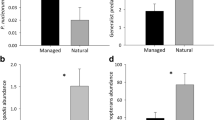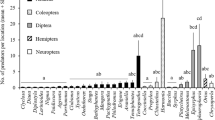Abstract
The influence of weedy field strips on the abundance patterns of western flower thrips, Frankliniella occidentalis (Pergande) (Thysanoptera: Thripidae), and predatory bugs of Orius spp. (Hemiptera: Anthocoridae), on faba bean and on weeds was investigated in Adana province, Turkey, during 2005–2006. There were two treatments: in one treatment, weeds at the margins and inside the plots were regularly controlled by tillage; in the other treatment no weed control was done. Thrips and Orius were sampled by beating faba bean plants and weeds. Orius niger (Wolff) was the most abundant predatory insect species in faba bean and flowering weeds, with numbers of adults and nymphs significantly greater in plots with weedy margins than in weed-free plots. Flowering weeds did not contribute to the abundance of F. occidentalis on faba bean. Abundance of adults of Orius spp. did not coincide with the abundance of F. occidentalis on faba bean or weeds. There were significant negative associations for numbers of Orius spp. among faba bean and the weed species Lamium amplexicaule L. or Sinapis arvensis L. (P < 0.05), indicating movement of Orius individuals from the weeds to faba bean during March–April. Finally, faba bean and weeds may provide some benefits to predators, such as nectar, pollen, shelter and egg-laying sites rather than as sources of insect prey. Cultivation of faba bean could be useful for conservation and augmentation of beneficial insects, including Orius spp. Furthermore, field margins bearing flowering weeds such as S. arvensis and L amplexicaule should be protected against destructive management practices, because they host considerable numbers of the Orius species.





Similar content being viewed by others
References
Anon. (2001). 8th Plan of the improvement of Turkey’s economy for five years: Plant production. Report of Sub-Commission of Cereals and Legumes, DPT: 2644-ÖİK: 652. Ankara, Turkey (in Turkish).
Atakan, E. (2006). Associations between Frankliniella spp. and Orius niger populations in cotton. Phytoparasitica, 34, 221–234.
Atakan, E. (2008a). Thrips (Thysanoptera) species occurring on winter vegetables crops in Çukurova region of Turkey. Acta Phytopathologica Entomologica Hungarica, 43, 227–234.
Atakan, E. (2008b). Thrips (Thysanoptera) species occurring on fruit orchards in Çukurova region of Turkey. Acta Phytopathologica Entomologica Hungarica, 43, 235–242.
Atakan, E., & Özgür, A. F. (2004). Within-plant distributions of predators Chrysoperla carnea (Stephens) (Neuroptera: Chrysopidae), Deraeocoris pallens Reut. (Heteroptera: Miridae) and Orius niger (Wolff) (Heteroptera: Anthocoridae) on cotton. Türkiye Entomoloji Dergisi, 24, 267–277 (in Turkish, with English summary.
Atakan, E., & Uygur, S. (2004). Seasonal abundance of some thrips species and their predators on weeds. Türkiye Entomoloji Dergisi, 28, 123–132 (in Turkish, with English summary).
Atakan, E., & Uygur, S. (2005). Winter and spring abundance of Frankliniella spp. and Thrips tabaci Lindeman (Thysan., Thripidae) on weed host plants in Turkey. Journal of Applied Entomology, 129, 17–26.
Atakan, E., & Gençer, O. (2008). Influence of planting date on the relationship between populations of Frankliniella flower thrips and predatory bug Orius niger in cotton. Journal of Pest Science, 81, 123–133.
Atakan, E., Özgür, A. F., & Kersting, U. (1998). Frankliniella occidentalis (Thysanoptera: Thripidae) on cotton in Çukurova Region. In: Proceedings of the Sixth International Symposium on Thysanoptera (Antalya, Turkey), pp. 7–12.
Bommarco, R., & Ekbom, B. (2000). Landscape management and resident generalist predators in annual crop systems. In B. Ekbom, M. Irwin, & Y. Robert (Eds.), Interchanges of insects between agricultural and surrounding habitats (pp. 169–182). Dordrecht, the Netherlands: Kluwer Academic.
Bosco, L., & Tavella, L. (2008). Collection of Orius species in horticultural areas of northwestern Italy. Bulletin of Insectology, 61, 209–210.
Bosco, L., Giacometto, E., & Tavella, L. (2008). Colonization and predation of thrips (Thysanoptera: Thripidae) by Orius spp. (Heteroptera: Anthocoridae) in sweet pepper greenhouses in Northwest Italy. Biological Control, 44, 331–340.
Bulut, E., & Göçmen, H. (2000). Pests and their natural enemies on greenhouse vegetables in Antalya. IOBC/ WPRS Bulletin, 23, 33–37.
Burgio, G., Ferrari, R., Pozzati, M., & Boriani, L. (2006). The role of ecological compensation areas on predator populations: an analysis on biodiversity and phenology of Coccinellidae (Coleoptera) on non-crop plants within hedgerows in Northern Italy. Bulletin of Insectology, 57, 1–10.
Coll, M. (2009). Conservation biological control and the management of biological control services: are they the same? Phytoparasitica, 37, 205–208.
Ekbom, B. S., Wiktelius, S., & Chiverton, P. A. (1992). Can polyphagous predators control the bird cherry-oat aphid (Rhopalosiphum padi) in spring cereals? Entomologia Experimentalis et Applicata, 65, 215–223.
Frank, T., & Reichhart, B. (2004). Staphylinidae and Carabidae overwintering in wheat and sown wildflower areas of different age. Bulletin of Entomological Research, 94, 209–217.
Gurr, G. M., Wratten, S. D., Tylianakis, J., Kean, J., & Keller, M. (2005). Providing plant foods for natural enemies in farming systems: Balancing practicalities and theory. In F. L. Wäckers, P. C. J. van Rijn, & J. Bruin (Eds.), Plant-provided food for carnivorous insects: A protective mutualism and its applications (pp. 341–347). New York, NY: Cambridge University Press.
Heimpel, G. E., & Jervis, M. A. (2005). Does nectar improve biological control by parasitoids? In F. L. Wäckers, P. C. J. van Rijn, & J. Bruin (Eds.), Plant-provided food for carnivorous insects: A protective mutualism and its applications (pp. 267–304). New York, NY: Cambridge University Press.
Hodek, I., & Honek, A. (1996). Ecology of Coccinellidae. Dordrecht, the Netherlands: Kluwer Academic.
Honek, A. (1982). Aphidophagous Coccinellidae (Coleoptera) and Chrysopidae (Neuroptera) on three weeds: factors determining the composition of populations. Acta Entomologica Bohemoslovaca, 78, 303–310.
Ives, A. R., & Settle, W. H. (1997). Metapopulation dynamics and pest control in agricultural systems. American Naturalist, 149, 220–246.
Kakimoto, K., Inoue, H., Yamaguchi, T., Ohno, K., & Takagi, M. (2006). Population trends of Orius sauteri (Poppius) (Heteroptera: Anthocoridae) on weeds in spring. Japanese Journal of Applied Entomology and Zoology, 50, 68–71. (in Japanese, with English summary).
Lacasa, A., Contreras, J., Sanchez, J. A., Lorca, M., & Garcia, F. (1995). Ecology and natural enemies of Frankliniella occidentalis (Pergande, 1895) in the Southeast Spain. Folia Entomologica Hungarica, 57, 67–74.
Landis, D., & Wratten, S. (2002). Conservation of biological controls. In D. Pimentel (Ed.), Encyclopedia of pest management (pp. 138–140). New York, NY: Marcel Dekker.
Landis, D., Wratten, S., & Gurr, G. (2000). Habitat manipulation to conserve natural enemies in arthropod pests in agriculture. Annual Review of Entomology, 45, 173–199.
Marshall, E. J. P., & Moonen, A. C. (2002). Field margins in northern Europe: their functions and interactions with agriculture. Agriculture, Ecosystem and Environment, 89, 5–21.
Murdoch, W. W., Chesson, J., & Chesson, P. L. (1985). Biological control in theory and practice. American Naturalist, 125, 344–366.
Nuessly, G. S., Hentz, M. G., Beiriger, R., & Scully, B. T. (2004). Insects associated with faba bean, Vicia faba (Fabales: Fabaceae), in southern Florida. Florida Entomologist, 87, 204–211.
Önder, F. (1982). Contribution to the study of Turkish Anthocoridae (Heteroptera). Bornova, İzmir, Turkey: Ege Üniversitesi, Ziraat Fakültesi Ofset Basımevi (in Turkish, with English summary).
Riudavets, J. (1995). Predators of Frankliniella occidentalis (Perg.) and Thrips tabaci Lind.: a review. In: A. J. M. Loomans, J. C. Van Lenteren, M. G. Tommasini, S. Maini & J. Riudavets (Eds.), Biological control of thrips pests (pp. 49–87). Wageningen Agricultural University Papers, 95.I, Wageningen, the Netherlands.
Shipp, J. L., & Zariffa, N. (1991). Spatial patterns of and sampling methods for western flower thrips (Thysanoptera: Thripidae) on greenhouse sweet pepper. Canadian Entomologist, 123, 989–1000.
Shipp, J. L., Zariffa, N., & Ferguson, G. (1992). Spatial patterns of and samplings methods for Orius spp. (Hemiptera: Anthocoridae) on greenhouse sweet pepper. Canadian Entomologist, 124, 887–894.
SPSS. (2006). SPSS base 15.0 user’s guide. Chicago, IL, USA: Prentice Hall.
Tavella, L., Bosco, L., & Faure, E. (2003). Distribution and population dynamics of Orius spp. in sweet pepper greenhouses in north-west Italy. IOBC/WPRS Bulletin, 26, 153–158.
Tavella, L., Tedeschi, R., Arzone, A., & Alma, A. (2000). Predatory activity of two Orius species on the western flower thrips in protected pepper crops (Ligurian Riviera, Italy). IOBC/WPRS Bulletin, 23, 231–240.
Thomas, M. B., Wratten, S. D., & Sotherton, N. W. (1991). Creation of ‘island’ habitats in farmland to manipulate populations of beneficial arthropods: predator densities and emigration. Journal of Applied Ecology, 28, 906–917.
Tommasini, M. G. (2004). Collection of Orius species in Italy. Bulletin of Insectology, 57, 65–72.
van de Veire, M., & Degheele, D. (1992). Biological control of the western flower thrips Frankliniella occidentalis (Pergande) (Thysanoptera: Thripidae), in glasshouse sweet peppers with Orius spp. (Hemiptera: Anthocoridae): a comparative study between O. niger (Wolff) and O. insidiosus (Say). Biocontrol Science and Technology, 2, 281–283.
Yaşarakıncı, N., & Hıncal, P. (2000). The studies on pests, their natural enemies and population developments on protected pepper in İzmir province. Bitki Koruma Bülteni, 40, 135–152 (in Turkish, with English abstract).
Acknowledgments
I would like to thank Dr. David Ben-Yakir (Department of Entomology, Agricultural Research Organization, The Volcani Center, Bet Dagan, Israel) for reviewing an earlier draft of the manuscript and Murat Ölçülü (Institute of Basic and Applied Sciences, Çukurova University, Adana, Turkey) for field assistance. I would like also to thank three anonymous reviewers for their valuable comments and suggestions which improved the manuscript.
Author information
Authors and Affiliations
Corresponding author
Rights and permissions
About this article
Cite this article
Atakan, E. Influence of weedy field margins on abundance patterns of the predatory bugs Orius spp. and their prey, the western flower thrips (Frankliniella occidentalis), on faba bean. Phytoparasitica 38, 313–325 (2010). https://doi.org/10.1007/s12600-010-0105-9
Received:
Accepted:
Published:
Issue Date:
DOI: https://doi.org/10.1007/s12600-010-0105-9




